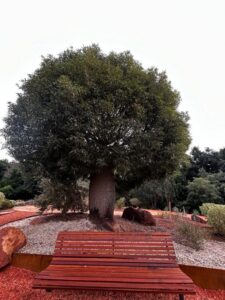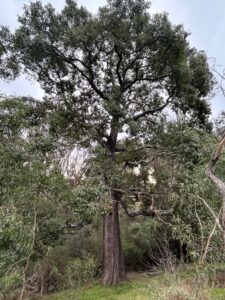
Australia’s iconic Bottle Trees and their enduring presence
By Michael Elgey
The genus Brachychiton, part of the Malvaceae family, comprises around 30 species which are endemic to Australia and one species native to Papua New Guinea. These trees have become horticultural icons, admired for their distinctive forms, adaptability, and spectacular seasonal displays.
Among the most recognisable are the Queensland Bottle Tree (Brachychiton rupestris), the Kurrajong (B. populneus), and the Illawarra Flame Tree (B. acerifolius). Others, such as Lacebark (B. discolor), Broad-leafed Bottle Tree (B. australis), and Little Kurrajong (B. bidwillii) along with a growing range of hybrids and cultivars, are also widely planted across the country.
You’ll find Brachychiton species lining historic avenues, standing proudly in public parks, and enriching curated garden landscapes throughout mainland Australia. Their striking bottle-shaped trunks, vivid flowers, and resilience in dry climates make them both beloved horticultural features and vital components of local ecosystems. They are living emblems of Australia’s unique and diverse botanical heritage.
My personal connection to Brachychiton began long before I formally entered horticulture. Growing up in western Sydney, I was often drawn to trees that looked markedly different from the dominant eucalyptus and exotic species in the area. I didn’t yet know their names, but I could sense they were uniquely different.
From my bedroom window, I vividly remember seeing several Illawarra Flame Trees erupt in crimson bloom, an unforgettable contrast to the suburban backdrop of terracotta roofs, remnant gumtrees, and well-established exotics. Equally memorable was a massive Queensland Bottle Tree in the front yard of a nearby house. Its swollen bulbous trunk towered over a modest fibro cottage and captured my imagination every time we passed by.

In nearby parklands, I came across Kurrajongs. Their distinct tapering trunks and curious seedpods fascinated me. Even as a kid, I sensed their uniqueness, though I didn’t yet know the full story behind them.
That story began to unfold in 2011 when I was fortunate to undertake a Plant Science Internship at the Royal Botanic Gardens, Sydney. During our training, we spent several days at the Australian Botanic Garden, Mount Annan (ABGMA), where I encountered the arboretum planting of brachychitons. It was here that I first made the connection between the trees from my childhood and the genus itself, except for the Illawarra Flame Tree, which I had learnt in my horticulture studies at Ryde TAFE. This was the moment my passion for brachychitons truly began to take root.
Later, as Curator of the heritage-listed Rockhampton Botanic Gardens and the Native Kershaw Gardens, I had the opportunity to explore the genus more deeply. Central Queensland offered increased exposure to increased diversity of species and cultivars thriving in cultivated settings, which further fuelled my interest.
Then, in 2021, I returned to ABGMA, this time as Curator Manager. The very site where my fascination with Brachychiton was awakened had now become my professional home. In addition to overseeing the 416-hectare site, including 30ha of curated collections, it included critically endangered a woodland plant community and large swathes of open grasslands all of which contain Brachychitons.
My favourite specimen isn’t in a prominent location. It grows quietly in a secluded gully between the base of Mount Annan and the Banksia Garden. It’s a majestic tree with strikingly contrasting trunks compared to the surrounding Eucalypt woodland and a powerful reminder of how plants, place, and memory intertwine.
In 2023 the Botanic Gardens of Sydney (BGS) published the Living Collections Strategy 2023+ which serves as a vital framework guiding the development, management, and conservation of BGS’ diverse botanical Living Collection. At the ABGMA the strategy, as Australia’s premier native plant botanic garden, is displaying extensive collections that reflect the unique flora of the continent, with a strong emphasis on conservation, research, and public education. Among its many plant families, the Malvaceae in which Brachychiton sits, is identified within the strategy as a key collection due to its ecological significance, horticultural potential, and conservation within the family.
As part of this, it is our desire to grow our collections for incorporation into the Kurrajong Arboretum as the trees in this collection are, at present, adaptable to our local environment. The collection is situated on a western exposure. The Kurrajong Arboretum presents a challenging environment for plant growth, with temperatures soaring up to 40ºC in summer and is exposed to fierce, blistering winds. Despite these conditions, the Kurrajong Arboretum demonstrates the remarkable adaptability and resilience of these trees. This resilience is a key factor to them being not only horticultural favourites but also important ecological contributors to the landscapes they inhabit, be that the built environment or within their natural ranges.
Beyond its aesthetic appeal, the Kurrajong Arboretum serves as a vital resource for conservation and research. By cultivating a diverse array of Brachychiton species, the arboretum contributes to the preservation of genetic diversity within the genus, and as the collection is predominately of wild-sourced material every individual has potential future conservation importance.
The arboretum’s design and curation offers visitors an educational journey through the world of Brachychiton trees. By engaging the public, the arboretum fosters a deeper appreciation for Australia’s native flora and the importance of plant conservation.
At present, ABGMA has 22 species and cultivars on display and our entire collection can be accessed online via our Garden Explorer portal: https://australianbg.gardenexplorer.org/
The Kurrajong Arboretum at ABGMA not only showcases the beauty and diversity of Brachychiton species but also underscores the importance of conserving Australia’s unique botanical heritage. Through its living collections, research contributions, and public education initiatives, the arboretum plays a pivotal role in promoting the understanding and preservation of these iconic trees that are an enduring presence on Australia’s landscape.
References
- Rathie, K. (2004). Brachychitons: Flame Trees, Kurrajongs and Bottle Trees. Darling Downs Tree Acclimatisation Society Inc., Toowoomba, QLD.
- Botanic Gardens of Sydney. (2023). Living Collections Strategy 2023+. Retrieved from: https://www.botanicgardens.org.au/
- Australian Botanic Garden Mount Annan. Kurrajong Arboretum Overview. Retrieved from: https://www.australianbotanicgarden.com.au/what-s-here/collections/kurrajong-arboretum
- PlantNET – FloraOnline. (Royal Botanic Gardens Sydney). Genus Brachychiton. Retrieved from: https://plantnet.rbgsyd.nsw.gov.au/
- Atlas of Living Australia. Brachychiton species distribution and ecology. Retrieved from: https://bie.ala.org.au/search?q=Brachychiton
- Australian National Botanic Gardens. Brachychiton fact sheet. Retrieved from: https://www.anbg.gov.au/gnp/gnp13/brachychiton.html
